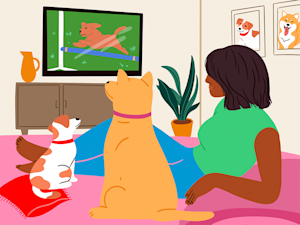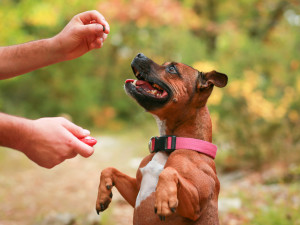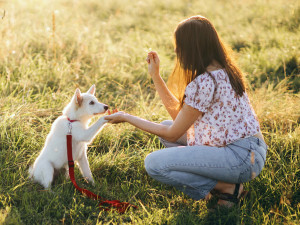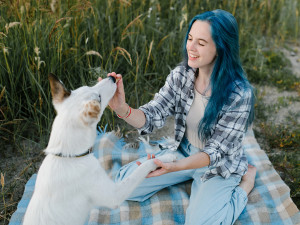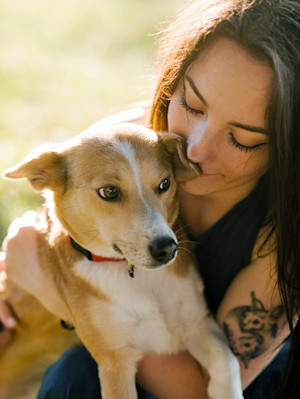Inside the Mind of a Dog Is Worth the Watch for Anyone Obsessed With Pups
A behaviorist’s take on what the Netflix documentary gets right (and a couple things it gets wrong).

Share Article
If they are anything like me, what most of my fellow dog people probably want to know about Netflix’s documentary Inside the Mind of a Dog is whether it’s worth watching. It’s a fair question, because nobody wants to tune in to something that won’t hold their attention. I mean, if anybody is going to be pulled away from Emily in Paris, Bridgerton, Stranger Things, or The Union, the show they watch should not be a waste of time.
Thankfully, Inside the Mind of a Dog offers a lot of value. Tuning in means you can spend 75 minutes enjoying dogs and hopefully learning something new about them. The “enjoying” part is easy — the show really delivers with beautiful footage of dogs: nursing puppies, canine athletes who leap and do full flips, dogs running in slow motion, charming doggie facial expressions, dogs jumping rope, and dogs loving (and licking) people.
You’ll learn a lot.
The information included in Inside the Mind of a Dog ranges from quite theoretical to very practical. Much of it is scientific in nature, which is validating after all the years that dogs were considered unworthy of study. Thankfully, research about dogs is now common, and that’s why we have learned so much about our best friends in recent years, including these issues discussed in this documentary:
Dogs share 99.9 percent of their DNA with wolves.
Dogs’ friendliness and cooperation is a winning strategy in evolution. Or, as scientists say, “Friendliness wins!”
Puppy-dog eyesopens in new tab are a real thing. The muscles around dogs’ eyes move in a way that pulls at human emotions, prompting us to want to take care of them.
Dogs have nose prints like we have fingerprints.
When dogs experience positive emotions, they wag their tails to the right.
High-pitch, repetitive barking indicates dogs are more upset than when they bark in other ways.
The bond between dogs and kids can buffer stressful events. The oxytocin produced when kids interact with a dog they are close to reduces their cortisol (stress hormones).
Early life stress influences fear and aggressive behavior in dogs later in their lives.
Classical music has a calming effect on dogs, and rock music has the opposite effect.
This doc provides a great education on the nuances of dog training.
As a trainer, I thoroughly enjoyed the section on training service dogs because it shows so much detail about training. They accurately present how dogs are trained and what that looks like in the real world. That’s important because the way service dogs are trained and raised is informative for everyone raising and training puppies. The professional service dog trainers in the film stress the need for lots of patience and lots of repetition, which I love.

I was also thrilled they emphasize practicing skills with distractions. As they describe it, “Yes, they can sit, but can they do it with a roller coaster behind them?” They took a dog to an amusement park to practice training them with all the noise, smells, and extreme distractions you’d expect, including a roller coaster.
Even more wild was the scene of a dog learning to be a detection dog working at a scent wall (a wall with many scents in containers that the dogs have to sniff and evaluate) while what looked like hundreds of tennis balls were poured out to scatter all over the floor as the dog kept working. It was a great way to show how a dog must be trained and tested for dealing with distraction. As a training nerd, I enjoyed the footage of dogs learning to operate light switches, open fridges, close the dishwasher, touch, shake, give, close drawers, and so many other skills.
I really enjoyed hearing how dogs are matched with different jobs depending on their individual characteristics. For example, when dogs are offered food containers that are locked, the dogs who try to get it themselves and problem-solve tend to be great at searching and detection work, as do hyperactive dogs. However, dogs who struggle to solve a problem and look to people for help do better as service dogs helping people with disabilities. Extremely steady dogs with a chronically calm demeanor are well-suited as partners to veterans with PTSDopens in new tab.
You can’t expect this movie to cover everything.
I’ve seen comments from people disappointed with Inside the Mind of a Dog because it didn’t have certain things in it they were hoping for, but that just speaks to how much there is to know about dogs.
Typically, people complain that dog-related content didn’t cover the particular issue they have with their dog, such as how to handle barking out the window at people passing by, how to cut the nails of a dog who is resistant to having their feet touched, and what to do if their dog likes to play with one child more than the other in the family.
A 75-minute documentary can only do so much, and most people want even more information about dogs — which is great. That doesn’t mean this documentary isn’t good — it is — but nobody should expect it to be comprehensive.
Don’t get me wrong: I had two big issues with this film.
Just because I am defending the movie against criticism doesn’t mean I loved everything about it, because I didn’t. For example, the title is misleading. There’s tons of great information about dogs in this documentary, but not a lot about their minds in the form of canine cognition work. It’s a catchy title, but it does not accurately describe what’s within.
Another issue is that I was surprised to see the dogs at service dog school wearing choke chains, as they are not generally considered appropriate training tools. Choke chains can injure dogs and cause them pain, though to be fair, the trainers never used them in a forceful manner, and the leashes were always loose.
The trainers used positive training methods with clickers and lots of treats, which is great. I just can’t understand why they were wearing choke chains at all. I certainly don’t want the families who are matched with the service dogs to use the choke chain. Plus, the training techniques were all so positive it’s hard to figure out why they had equipment on the dogs that has historically been used in other, less humane methods.
That criticism aside, there’s so much worth raving about in this documentary. But I think it can all be summed up with a line from actor Rob Lowe’s narration, “We can all get closer to our dogs if we know their secrets.”

Karen B. London, PhD, CAAB, CPDT-KA
Karen B. London is a certified applied animal behaviorist (CAAB) and certified professional dog trainer (CPDT) who specializes in working with dogs with serious behavioral issues, including aggression. She has written for a variety of magazines including The Bark, Clean Run, and the APDT Chronicle of the Dog, and has published in scientific journals including Behavioral Ecology and Sociobiology, Ethology, Ecology, and Evolution, the Journal of Insect Behavior, and Insectes Sociaux. She is the author of seven books about dog training and canine behavior, including the forthcoming My Dog's Mystery Adventure: And Other Stories From a Canine Behaviorist and Dog Trainer.
Related articles
![Brown, half breed dog sitting on a chair next to his owner, a blonde stylish woman wearing a brown smart suit.]()
Your Dog Can Read Your Mind, Kind Of
Researchers say dogs actually have a pretty good sense of what we’re thinking.
![girl with blue hair starting puppy training with white dog]()
Puppy Training 101: How to Train a Puppy
You gotta start somewhere.
Do Dogs and Cats Care What They Look Like?
They do seem to act different after a trip to the groomer, right?
![Couple hugs their merle Boxer]()
How to Improve Your Relationship with Your Dog
Animal behaviorist Dr. Karen B. London on how to strengthen your pet-parent bond.
![a small dog looking disgusted]()
6 Scents Your Dog Probably Can’t Stand
A dog’s sense of smell can be 100,000 times stronger than a human—so when it’s bad, it’s bad.
![Brunette girl with tattoo on shoulder hugs dog.]()
Do Dogs Get Grumpy? Yes, So Here’s How to Cheer Them Up
Canine grumpiness is very real and the summer heat doesn't help.
